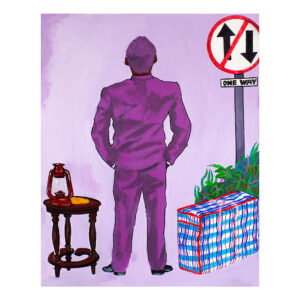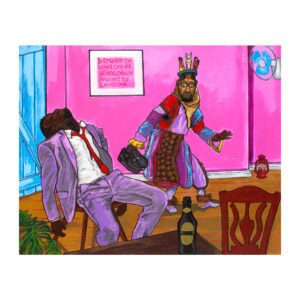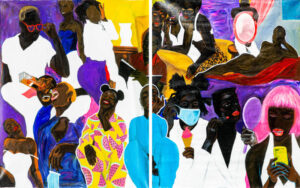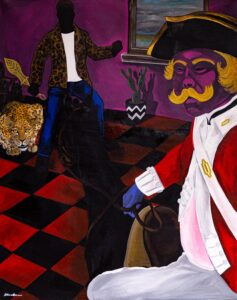
John Madu
About:
John Madu, born in 1983 in Lagos, is a Nigerian multi-disciplinary artist best known for his figurative and symbolic paintings. His eclectic work derives ideas from a range of influences based in popular culture, personal experiences, African history and art history. Madu’s works are typically dense with symbolism, featuring recurring iconography that conveys a certain meaning or a particular metaphor. Here, Madu talks more about his practice, his artistic beginnings and the work he has presented in The Medium is the Message.

One Way, 2019
UL: Could you talk us through your materials and creative process, from the first stages to the finished piece?
JM: Primarily, my creative process stems from my thought process. I would say that my educational background in policy and strategic studies has shaped this process. I follow a natural flow of research and idea development, which explores and filters all possible concepts until I am ready with an innovative idea that can become a reality.
I use a wide variety of mediums, but acrylic and oil paints constantly reoccur throughout my work. My use of medium can vary, depending on how I feel it will pass on a particular message. For example, if I want to work on creating a textural effect, I might choose to use burlap over paint in order to achieve this result. Most times the outcome or the finished piece is obscure in my mind until I start the actual physical creative process. Once the idea becomes more visible in my mind, after some research, I get to work.

UL: Your work seems intrinsically tied to your homeland of Nigeria; would you agree? How do you think growing up in Lagos has affected your practice?
JM: I believe my identity as a Nigerian is innate to my work, but I’m not solely tied to my homeland in the sense that my inspirations and thematic concerns are mostly broad and universal. However, I still view the world and record its history from the perspective of the corner of the earth I identify with the most. I think if I grew up in a different part of the country, I might not have honed my natural artistic talents. Growing up in the suburbs, on Allen avenue, in the 80s definitely influenced the way I saw the world. There were arcade centres, barber shops, hairdressing salons, boutiques, restaurants, a water park and the largest video club in Lagos. There were also quite a number of street artists displaying art on different street corners. It was an actual cultural centre. I believe this access to popular culture shaped the way I wanted to create artistically as my work is usually a reflection of my own experiences and contemporary life.
Equally, every time my father travelled for his business trips, he bought comic books for my siblings and me. As a young and wide-eyed aspiring artist, these influenced me to play around artistically and create my own action-packed comic strips. I actually found some pages from my childhood comic strips a month ago; you can image the feeling of nostalgia I had.

City boys X City girls B.C I and II, 2020, acrylic on canvas, Diptych. Each work: 151.5 x 121 cm
UL: You wrestle with highly charged subject matter – for example, the colonial theme in the Invader series – yet, the palette you use is bright and disarming. What is your thinking behind this disparity of feeling?
JM: My intention was to play around with history and its narrative by using fictional characters. Quite often, I imagine the way I might have preferred a certain historical event to have gone down. The concept behind Invader I actually came from a selfie my friend took when we went horse riding together (my first time riding a horse by the way). The perspective of him on horseback makes him seem larger, but also captures the rest of the scene in the background. I had cultural intentions when creating this piece, which stemmed from conversations of how our history and our stories are mostly told by outsiders. In the painting, the selfie taker becomes the narrator of the entire picture. Whatever story he tells is told only from his perspective. I replaced the selfie taker with the character of the invader.

Invader I, 2020, acrylic on canvas, 151 x 121 cm
It is important that more people of African descent tell their own stories. I would say that, with the help of technology, social media and other digital platforms, people of African descent have been given more of a voice and the ability to record their stories. More than ever, we can speak of new trends, identities and cultural waves that are coming from Africa.
UL: In the past you have said painting should be didactic. What wisdom are you trying to impart through your work? For example, are you saying we must be careful and stop and look, or that history may repeat itself?
JM: Mostly, after I complete a work, I think about the future and how people will feel when they view my artworks fifty years from now. I believe that, as an artist, my work is a record of the history of my time. It becomes a form of archival documentation of various experiences and struggles that are both personal and societal. I feel it’s important to look closely at our own history to help us move forward. History should not be totally ignored.
UL: After The Medium is the Message what is next for you in terms of shows? Do you see the style or subject of the work itself changing in the near future?
JM: I have a solo show coming up next year and a group show in the works. Portraiture and figurative painting have always been my main areas of interest and practice. Since childhood, my works have been populated with faces and bodies. Sometimes, I might use different techniques and mediums to convey a particular point. I’ve used collages, impasto or mixed media. I don’t see a shift from that; I believe my work will just continually evolve with the trends of time. (text UnitLondon)
